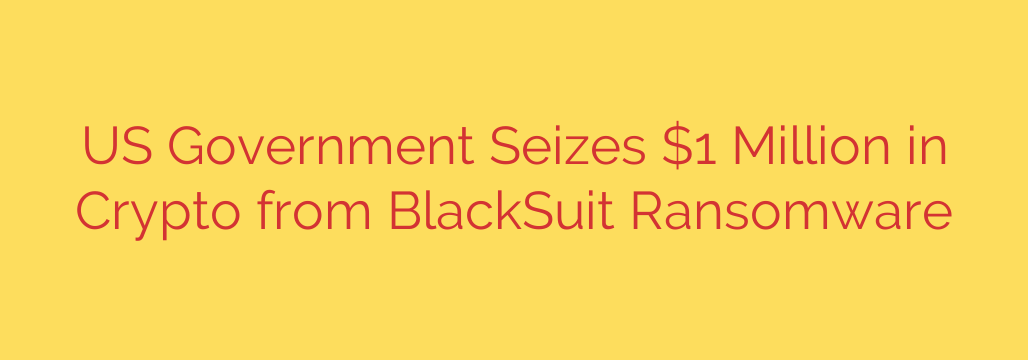
U.S. Government Claws Back Over $1 Million from Notorious BlackSuit Ransomware Group
In a significant victory against digital extortion, U.S. authorities have successfully seized cryptocurrency valued at over $1 million from the BlackSuit ransomware gang. This decisive action, spearheaded by the Department of Justice (DOJ) and the Federal Bureau of Investigation (FBI), strikes a powerful blow against a cybercriminal organization known for targeting critical infrastructure and demanding hefty ransoms.
The operation highlights a growing strategy by law enforcement to disrupt the financial lifelines of ransomware groups, making their illicit business model less profitable and more difficult to sustain. By tracing and confiscating these digital assets, authorities are moving beyond just identifying attackers and are now actively dismantling their operational capabilities.
Who is the BlackSuit Ransomware Gang?
BlackSuit is a dangerous ransomware variant that emerged as a significant threat to organizations worldwide. Like other ransomware groups, its primary method of attack involves infiltrating a network, encrypting sensitive files, and demanding a large payment in cryptocurrency in exchange for the decryption key.
However, BlackSuit often employs a “double extortion” tactic. This means that even if a victim has backups and can recover their data, the attackers threaten to leak the stolen, sensitive information publicly if the ransom is not paid. This puts immense pressure on organizations, especially those in sectors like healthcare, education, and government, who handle private and confidential data.
Security researchers have noted strong technical overlaps between BlackSuit and other notorious ransomware families, such as Royal and Conti, suggesting that BlackSuit may be a rebranded or splintered version of these well-established cybercriminal enterprises. This connection indicates that the operators behind BlackSuit are experienced, sophisticated, and highly capable.
The Impact of Seizing Ransomware Profits
Confiscating ransomware proceeds is a critical component of the modern fight against cybercrime. Here’s why this seizure is so important:
- Financial Disruption: It directly removes funds that would have been used to finance future attacks, improve their malicious software, and pay affiliates.
- Deterrence: Successful seizures send a clear message to cybercriminals that their cryptocurrency profits are not untouchable. Advanced blockchain analysis and international cooperation are making it harder to launder and hide illicit funds.
- Building Confidence: Actions like these demonstrate to the public and private sectors that law enforcement is developing effective capabilities to counter high-tech financial crime.
This operation serves as a stark reminder that paying a ransom comes with no guarantees. Victims may not get their data back, and they may be targeted again in the future. Furthermore, paying ransoms fuels the entire ransomware ecosystem.
How to Defend Your Organization Against Ransomware Attacks
While law enforcement is making strides, the ultimate defense begins with a robust and proactive security posture. Organizations can take several critical steps to protect themselves from threats like BlackSuit.
1. Maintain Secure, Offline Backups: The single most effective defense against a ransomware attack is having clean, tested, and isolated backups of your critical data. Follow the 3-2-1 rule: three copies of your data, on two different media types, with at least one copy stored off-site and offline.
2. Implement Multi-Factor Authentication (MFA): Many ransomware attacks begin with compromised credentials. MFA provides a crucial layer of security that can stop an attacker from gaining access, even if they have a user’s password.
3. Keep Systems Patched and Updated: Ransomware often exploits known vulnerabilities in software and operating systems. Establish a rigorous patch management process to ensure all systems are updated as soon as security patches become available.
4. Train and Educate Your Employees: Your staff is your first line of defense. Conduct regular security awareness training to help them identify and report phishing emails, suspicious links, and other social engineering tactics that are common entry points for ransomware.
5. Develop an Incident Response Plan: Don’t wait for an attack to happen to figure out what to do. Create and practice a detailed incident response plan that outlines the specific steps to take, who to contact, and how to communicate during a security breach.
This successful seizure by the U.S. government is a welcome development in the ongoing battle against cybercrime. However, it underscores the persistent threat that ransomware poses. For businesses and individuals, the message is clear: vigilance, preparation, and strong security hygiene are non-negotiable in today’s digital landscape.
Source: https://www.bleepingcomputer.com/news/security/us-govt-seizes-1-million-in-crypto-from-blacksuit-ransomware-gang/








